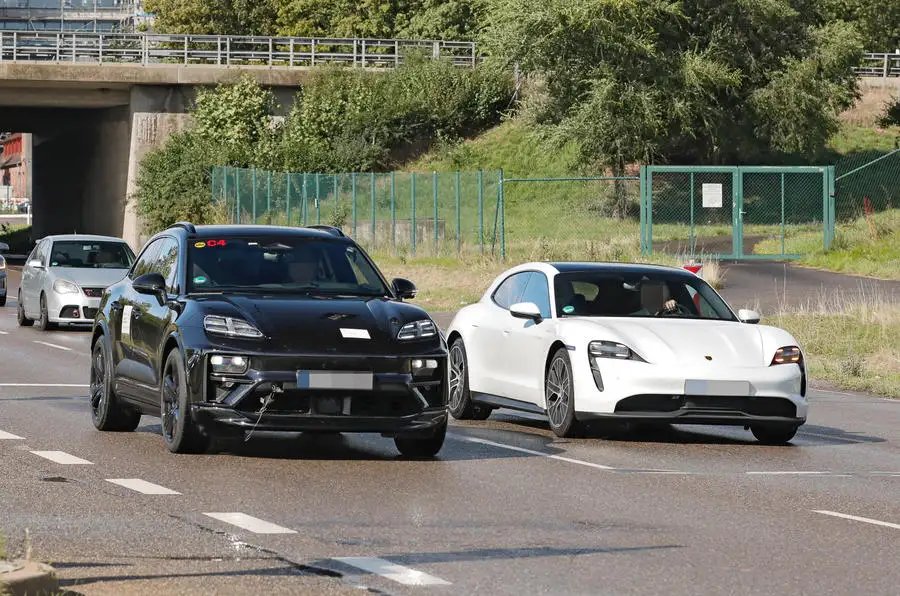2024 Porsche Macan EV to bring 603bhp and 100kWh battery

The upcoming Porsche Macan EV, the German brand's critical first entry into the electric SUV segment, has been spotted in its closest production-spec form to date.
Sporting no camouflage at all and importantly no covered exhausts – previous mules had used ICE Macan bodies – the SUV shows off a slightly different design from the combustion car it will be sold alongside, which itself received a facelift last year (and a technical boost this year) that distinguishes the pair.
Key changes have resulted in a more angular face, replacing the current Macan’s blockier design. This also gives the headlights a sharper shape, more in line with those of the bigger Porsche Cayenne, and the front daytime light bars have been replaced by two sets of twin circular lights.
A close relationship to the Cayenne is also apparent at the rear, where the Macan EV swaps the previously bulbous design for a more angular one.
Deliveries of the Macan EV, which will share its PPE architecture with the similarly sized Audi Q6 E-tron, are scheduled for 2024. It was originally planned for this year, but was delayed by development difficulties at Cariad, the Volkswagen Group’s software division.
Antoon Janssen, Porsche powertrain manager for the Macan line, told Autocar that it intends for the Macan EV to be the sportiest car in its class.
As such, it receives a pair of permanently excited electric motors – one per axle – similar to those used in the Porsche Taycan.
However, these have been heavily reworked to boost power density and efficiency, featuring a new ‘double V’ magnet arrangement and switching from a silicon semiconductor to silicon-carbide. The latter reduces switching losses – effectively power leakage – in the motors’ pulse inverters.
These improvements yield power outputs of up to 603bhp, with more than 738lb ft of torque, sent to all four wheels. The firm has not commented on whether an ‘overboost’ function – as offered on the Taycan Turbo S to temporarily raise power and torque to 751bhp and 774lb ft – will also be available on the Macan EV.
Rear-wheel drive is also possible on the PPE platform, said Janssen, although this will initially be used only to decouple the front motor when cruising to reduce rolling resistance (and conserve energy).
Dynamics have also been a point of emphasis for the Macan EV. Model chassis manager Dominik Hartmann confirmed that it will have a "performance rear axle", with the motor mounted as far back as possible. This gives a weight distribution of 48% at the front and 52% at the rear, to maximise traction. For reference, the Taycan’s mass is divided 49:51 front to rear.
Porsche also confirmed that the tyre widths will be more staggered than on the current Macan – the existing GTS variant uses 265mm-wide rubber up front, but 295mm-wide tyres at the rear – to accommodate the rearward weight bias and further improve grip.
The Macan EV will also be the first model to receive Porsche’s two-valve dampers, which are said to enhance ride comfort because they enable independent adjustment via the Porsche Active Suspension Management (PASM) system. This will also lower the suspension at certain speeds to improve the car’s aerodynamic profile and reduce energy consumption.
To improve manoeuvrability, the steering angle has been increased by 15% over the petrol car, and rear-wheel steering up to 5.0deg (below 50mph) has been added.
The most expensive versions of the Macan EV will also get an electronic locking differential mounted at the rear axle, designed to improve its front-rear torque-vectoring capabilities.
All variants will receive a 100kWh lithium ion battery, which, Porsche stated, is the optimum size for minimising journey times. The company has offered no range prediction, but an optional 93kWh battery gives the lower Taycan enough power for 314 miles per charge. The PPE platform’s 800V architecture allows maximum charging rates exceeding 270kW.
However, trick hardware and software developments mean that the battery can respond to 400V chargers by splitting the single 800V battery into two halves. This boosts charging speeds, said Janssen, although he did not confirm how significant this impact was.
Janssen also confirmed that the PPE platform could be extended to fit more battery modules. The Macan uses 12 prismatic cells. This implies that the eventual Porsche Cayenne EV (which is tipped to also use the PPE platform) could have an even greater battery capacity in order to compete with the Mercedes-Benz EQS SUV.
Nonetheless, the long-term goal for Porsche’s road-going cars is to reduce the size of the batteries, according to Florian Modlinger, the firm’s Formula E boss. This “must be the target,” he said, although he acknowledged that this “will take longer” than in motorsport.
The Macan EV is the next model in an assault of Porsche EVs due over the next few years, which include the 718 Boxster EV (2025), the electric Cayenne (2025) and the Panamera EV (2026).
Later this decade, a new electric SUV, known to be a seven-seater codenamed the K1, will arrive. It is thought this model will be Porsche’s most expensive car and represent a complete styling revolution for the marque.
Porsche aims for electric vehicles to account for 50% of its global sales in 2025, and 80% by 2030.
Verwandte Nachrichten
